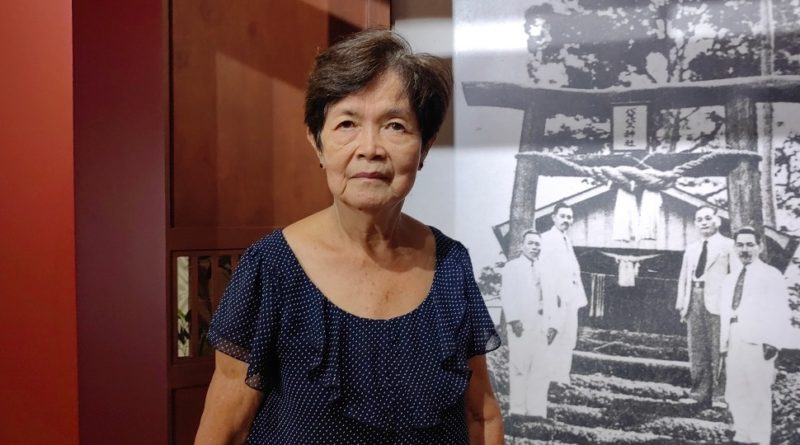How a Teacher in Davao Finally Met Her Japanese Father Three Decades After WWII
The stars just aligned. / By JILL TAN RADOVAN

Early Japanese settlement in Davao
Japanese settlement in the Philippines began many years before World War II. As early as 1903, relations between the Philippines and Japan started when Suda Ryosuke, a man from Kagoshima Prefecture, brought a group of Japanese men to Davao as migrant workers. These men worked in the abaca plantations, initially at the Awad Plantation at Lapanday, in the municipality of Sta. Cruz. Life for them, however, turned out to be difficult. This first batch of workers returned to Japan after one year.
.JPG)
In 1904, the 180 Japanese men who had been brought to the Philippines to work on the construction of Kennon Road in Baguio but whose contracts had already lapsed were sent to Davao. Ota Kyosaburo, a merchant from Kobe otherwise known as K. S. Ohta, was supposed to find new jobs for these men in Sorsogon but sent them to plant and harvest abaca in Davao instead. Ohta became a middleman for plantation owners who sought laborers and Japanese workers looking for jobs. Japan, at the time, was a relatively poor country, far from the First World nation that it is today.
Ohta was optimistic about Japanese-Philippine trade and founded the Ohta Development company. He arranged for the importation of Japanese workers into the Philippines. In January 1905, 100 more Japanese laborers arrived to work in the abaca plantations; 70 more from Okinawa followed in July. The same year, Ohta settled permanently in Davao and opened a store catering to the needs of Japanese customers.
The Japanese turned abaca into a major Philippine commodity. They even invented the hagutan, an abaca-stripping device made from hard metal. More and more immigrants from other Japanese regions settled in Davao. By the late 1920s, the Japanese had taken over the abaca industry in the province—not through ingenuity alone, but also, reportedly, through less-than-savory means.
The Japanese took control of Davao’s most prosperous agricultural areas in 1930, leading to the displacement of indigenous tribes. Even Okinawans or Ryukyuans, the early settlers, felt discriminated by non-Okinawan Japanese.
.jpg)
.
A Ryukuan and Boholana meet
By 1939, there were 17,888 recorded Japanese immigrants in Davao. Kashin Teruya, Carmen’s father, was one of the migrant workers from Okinawa who settled in the area. There he met Catalina Cael, a young woman who migrated from Bohol to look for work and who was later employed as a domestic helper by a Japanese military officer, Captain Nakasone, and his wife.
Japanese military forces invaded the Philippines on December 8, 1941—only 10 hours after the country attacked Pearl Harbor, which marked the start of the war in the Pacific. Davao, along with other areas, fell under complete control of Imperial Japan. Captain Nakasone and his family—along with their housekeeper, Catalina—fled to a garrison to ensure their safety in 1942.
Among the other evacuees in the same garrison was Kashin Teruya. He and Catalina eventually became friends. Soon enough, a romance blossomed between the two—with the Second World War as their backdrop.
.
The Japanese occupation and the Philippine guerilla movement
Japanese authorities organized a new government structure in the Philippines and controlled all civil affairs through a puppet government led by President Jose P. Laurel. Under the Japanese occupation, more than a thousand Filipinos—women, girls, and gay men—were imprisoned and forced into sexual slavery for the benefit of Japanese soldiers. Resistance against the Japanese emerged, leading to the beginning of the Philippine guerrilla movement.
The rebel movement against the Japanese overlords was immensely successful, with post-war investigations showing that over 260,000 people were part of guerrilla organizations across the country. The commanders of these rebels worked together not only to fight the Japanese; they also gathered intelligence to assist the return of the American forces. General Douglas MacArthur found ways to smuggle guns, radios, and supplies in support of the guerrilla forces., which had become so powerful that by the end of the war, the Japanese controlled only 12 out of 48 provinces in the country.
During the Battle of Manila, General Tomoyuki Yamashita ordered his officers to destroy Manila’s bridges and port to slow down the returning American forces. General Douglas McArthur had preemptively announced the city’s liberation after his return in 1945. When Yamashita withdrew, Rear Admiral Sanji Iwabuchi ordered his men to tear down businesses and historical landmarks and to commit a barbaric massacre that led to the torture and killing of thousands of civilians, American troops, and rebel forces. On one occasion, as many as 1,000 guerrilla soldiers were burned to death, as cited by an entry in a Japanese soldier’s diary.
.jpg)
The US forces fought back. They used bazookas and flamethrowers and fired howitzers at Japanese troops at point-blank range. By the end of the battle, it might have been difficult to discern who had done more damage—the Americans or the Japanese. The death toll of civilians in the Battle of Manila, which happened from February 3 to March 3, 1945, is estimated to have reached 100,000 to 240,000, and presumably more if the number was to cover the deaths of American, Filipino, and Japanese troops.
The Surrender of Japan and the end of WWII
Emperor Hirohito announced his acceptance of the Potsdam Declaration—signifying Japan’s surrender—on August 15, 1945, roughly a week after Enola Gay, an aircraft of the US Air Forces, dropped an atomic bomb over Hiroshima; the Soviet Union invaded Manchuria, a Japanese puppet state; and the Americans bombed Nagasaki.
Japan officially surrendered aboard the USS Missouri in Tokyo Bay on September 2, with Japanese Foreign Minister Mamoru Shigemitsu signing on behalf of the Japanese government and General Yoshijiro Umezu signing for the Japanese Armed Forces. This ultimately signified the end to WWII.
Repatriation
While Davao had become a furusato or second home to the Japanese workers, many of them still longed to return to their homeland. One of them was Kashin Teruya, Carmen’s father, who was repatriated in 1945.
Catalina was two months pregnant at the time of Kashin’s repatriation. Before leaving, Kashin provided Catalina with documents containing his personal information, including his address in Okinawa. He also left some money for Catalina and their baby.
Filipino guerrilla soldiers, however, confiscated everything, leaving Catalina with no means to get in touch with the father of her child. Their daughter, Carmen was born in February 1946. Two years after, in 1948, Catalina’s relatives arranged for mother and daughter to be sent to Bohol, their home province.
Photograph of the Bayabas Shrine in Toril, Davao
.jpg)
Return to Davao
In 1961, relatives from Davao visited Catalina and Carmen in Bohol. Carmen, who was then 15 years old, asked the relatives to help her return to Davao. The small town in Bohol where she and her mother lived was around 30 kilometers away from Tagbilaran, the capital. It provided a minimal opportunity for Carmen to earn income or pursue higher education.
The relatives agreed to sponsor Carmen’s trip to Davao. They took her under their wing and sent Carmen to school. In June of the same year, Carmen resumed her studies at the Holy Cross College of Calinan, where she also earned an Education degree in 1969. She stayed with her relatives for 12 years and only left their home when she got married in 1973. While studying, Carmen worked as a shop assistant to support her uncle’s buy-and-sell business.
After graduating from college, Carmen immediately landed a job working as a public school teacher in Calinan. She used her mother’s surname, Cael, and resisted telling her colleagues about her Japanese bloodline or the circumstances surrounding her ancestry.
“I kept it secret,” Carmen said in an interview with Esquire Philippines. “Hindi ko talaga sinasabi na may lahi akong Japanese. Conservative pa din kasi.” Carmen was too embarrassed to admit that she had been conceived out of wedlock at the height of the war.
A striking coincidence
Every year, a group of aging Japanese citizens visit Davao in August to celebrate Obon, an annual Japanese holiday dedicated to commemorating and remembering one’s ancestors. The occasion is similar to All Souls’ Day. In August 1979, Japanese tourists arrived in Calinan, as expected by the locals.
Carmen’s brother-in-law worked as a part-time driver for Yoshihiro Yamaniha, one of the Japanese visitors. He told Mr. Yamaniha that his sister-in-law was half-Japanese and that her surname would have been Teruya had she adopted the surname of her father. Coincidentally, the surname of Mr. Yamaniha’s roommate at the Insular Hotel at the time was also Teruya.
When Mr. Yamaniha told Mr. Teruya about Carmen, the latter got excited and confessed that he had been searching for Carmen and her mother for a long time and had even requested the assistance of then-mayor Elias Lopez. The search proved to be challenging; they were unable to locate Carmen until that day. Carmen kept mum about her Japanese heritage and only had her mother’s last name—Cael—in official documents, including her birth certificate.
Mr. Teruya, apparently, was the relative of Kashin Teruya, Carmen’s father, who had long been based in Okinawa post-repatriation, where he lived with his son, another daughter, and son-in-law.
The Teruyas of Okinawa requested Carmen to produce documents to show that she, indeed, was the long-lost daughter of Kashin Teruya. She had old photographs of herself and her mother and nothing more because all the documents linking them to her father had been confiscated.
Carmen even went to her mother in Bohol and asked her to provide information that would help Carmen prove to her supposed siblings from Okinawa that she was their half-sister. Her mother refused to cooperate and did not want to establish any connection with her former lover and his family.
Carmen reported this to her siblings, who suggested asking her mother for a testimony that would shed light on Carmen’s relation to the Teruyas. Still, Catalina, Carmen’s mother, refused. Carmen eventually got tired of trying to prove her identity and decided to give up. She wrote a letter to her siblings in Okinawa and told them that it would be the last time they would hear from her and that she was content knowing that her father was alive and she had two older siblings in Okinawa.
Carmen got the surprise of her life when her siblings responded and said that they would be heading for Davao in a few weeks. Her siblings sent Carmen money so she could buy a ticket that would allow her to bring her mother to Davao from Bohol.
Knowing that her mother would disagree if she had known the real score, Carmen nonchalantly invited her mother to Davao for a vacation, and Catalina obliged.
Carmen Apigo at the Philippine-Japan Historical Museum in Davao City
.jpg)
Meeting for the first time
On November 29, 1979, Kashin Teruya, accompanied by his son, daughter, and son-in-law, arrived in Davao. It was his first visit to the province since his repatriation more than three decades prior, and the first time he would see his youngest daughter, Carmen, in the flesh. Carmen was 33 years old when she first met her father, Kashin, who was already 88 years old.
Catalina chided her daughter for not telling her about Kashin’s anticipated return. She was quite stunned when she saw Kashin again for the first time after 34 years. The tension broke down eventually, and for the first time in her life, Carmen saw her parents engage in a conversation, face-to-face—in Chavacano! She was surprised to learn that her seemingly frail, 88-year-old father could still speak the dialect.
“I really appreciate my father because, despite his condition, he came to Davao to visit me,” Carmen said.
Carmen’s siblings invited Carmen and Catalina to move to Okinawa. Kashin was already a widow; his wife, the mother of his other children, had died in 1955. Having Catalina in Okinawa would not have been a problem.
“You don’t have to worry, you are now our sister,” Carmen’s siblings told her.
Carmen, who was successfully and happily navigating her career as a schoolteacher, refused her family’s invitation to relocate to Japan. But she would occasionally visit them in Okinawa years after and remained in touch with her Japanese family throughout the years.
The first time Carmen visited Okinawa was in 1990, which she arranged upon learning that she would be attending a conference in Japan. Carmen recalls being treated with utmost hospitality by her relatives in Okinawa, and even attending a welcoming banquet in her honor, as well as a going-away party before her departure.
Ten years after, in the year 2000, Carmen visited Okinawa again. Her son accompanied her on her last trip to Okinawa, in 2013.
Kashin Teruya may have missed most of the milestones in Carmen’s life but tried to make up for his absence within the remaining time he still had.
When he died, Carmen’s older sister told her, “I envy you. Our father died with a picture of you and your family in his hands.”
The Philippine-Japan Historical Museum is open to the public and found in Calinan, Davao City. Visit the museum’s Facebook page for more info.
If you’re thinking of flying to Davao for a long-deserved vacation, download the airasia Super App and book your next flight. AirAsia Philippines flies two times daily and 24 times weekly from Manila to Davao.


 Memento Maxima Digital Marketing @
Memento Maxima Digital Marketing @ Ads by: Memento Maxima Digital Marketing
Ads by: Memento Maxima Digital Marketing






